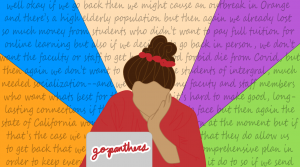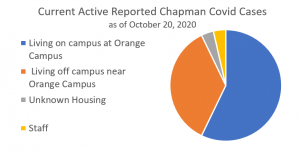
Sophomore business administration major Sam Barela was shocked early Fall Semester by his professor’s awe at Chapman’s low COVID-19 numbers. Low? Adler knew that at his house of eight ALL tested positive for the virus at the end of August.
That’s about how many Chapman was reporting total at the time.
Chapman has sent out countless updates about corona, but there’s still an aura of confusion amongst the student body about what Chapman can actually do to keep them safe.
Since Chapman returned to a partial hybrid system — coupled with the recent spurt of COVID-19 cases in the K student housing, students are even more fearful of what’s to come from returning to in-person instruction.

When offered the chance, most opted to say, “No thanks.” Some departments are reporting that less than 3 percent of their classes are on campus as hybrid experiences (just half a class at a time.)
As of this week, Chapman still reports no more than 30 known COVID cases among students.
Sophomore psychology Annie Rooks thinks the numbers are far higher than that. And she doesn’t trust her own peers to act responsibly during the pandemic:
“I don’t trust college kids—I think they’re selfish and think they’re invincible and when my professors asked me to go back, I said no.”
Junior business major Lily Moore is one of the three of her housemates who tested positive for the virus. She personally knows 13 students from Chapman who all tested positive. Moore received her result at the end of August, She was able to quarantine alone in her room, and luckily since her symptoms weren’t severe, she was able to work through classes fairly well.
But Dean of Students Jerry Price points out Chapman numbers are not higher because students aren’t reporting it. But he is also convinced the overall numbers are not as high as some students fear:
“I have no doubt that there are students living off-campus who have tested positive and not shared their results with us. However, I have no real reason to believe that number is exceptionally high. If it were, I feel it is inevitable that we would be seeing more positive tests among students living on campus or attending class in person.”
All protocol is listed on Chapman’s website. Even so, most interviewed students thought there was so much information in so many places that understanding what to do got lost in the countless articles, town halls, and protocol updates.
Price added that one reason only active cases are reported is a fear of panic.
“The whole point of giving out information is that people can use it and factor that in choices they make, not just to satisfy people’s curiosity.”
One of the faculty members on the CU Back Safely team (who preferred to stay anonymous) explained the complexities of the entire COVID-19 situation as almost a battle among five factions: the students, the parents, the state, the board of trustees/donors, and the faculty.
Essentially, each of these groups has their own power and own feelings towards the situation—then, add on the financial aspect. In an email sent out to faculty and staff on August 7th, President Struppa showcased how COVID-19 resulted in the non-profit university’s loss of at least 111 million dollars.
But President Daniele Struppa says money is not an issue in its decision-making. In an interview with Fox News, Struppa explained:
“Our decision is completely guided by our desire to provide the best possible education to our students. We are going to do what is safe.”
Students have opted to stay home this semester for two reasons: They worry about their own safety, and their parents don’t give them a choice. Still, students agree they miss campus.
Said Junior accounting and business administration major Hannah Tempki: “In person classes give regularity to my schedule, which helps me be more productive overall.
However, she, and many other students, don’t think returning this semester would be safe. Also, the university recognizes that not everybody would abide by the healthy and safety rules for a full return to campus.
“It’s unrealistic not to expect all students to comply,” said Dean Price. “Students understand this as well as anybody else.”
But he also believes the student body, once a return comes, will mostly be aware of risks and have knowledge of precautions, and can make educated decisions on how and when to socialize with peers.
But the risks are still there.
Barela thinks he and housemate sophomore, business administration Brian Lynberopoulos contracted the virus while having lunch with a friend the week before. All eight students living in the house tested positive for COVID-19 but they never reported this to Chapman; Adler explained they lived off-campus, were able to quarantine, and they didn’t know they had to self-report.

And for future semesters?
Sophomore health science major Lexie Ascher suggests, “It will take a very long time to have no restrictions, and I think this online thing will change a lot in the future, like always having office hours/SI sessions online or have some classes be online even without COVID.”
